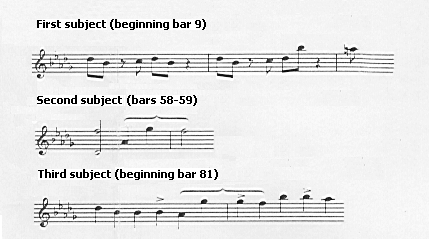Example 14: The
relationship between the first, second, and third subjects of
the first movement

Réti regards these three themes as the basic material from
which the whole movement is built in constant ornamentation, yet "with an
almost rigid adherence to the basic idea."
This is consistent with what most analysts would observe with regard to a
movement in sonata form. Furthermore, he emphasises the fact that once the
unified structure of the first movement has been clarified by the analyses
presented thus far, "...the design of the following movements as the natural
outgrowth of the first cannot be mistaken."
The next important point emphasised by Réti is that of the
effective manner in which Chopin connects the first movement with the Scherzo.
By comparing the coda of the first movement as it rises from d2 - b
flat2 - a2 (bars 230-236) to the Scherzo theme, the
similarity in outline becomes obvious, as shown in Examples 15(a) and 15(b):